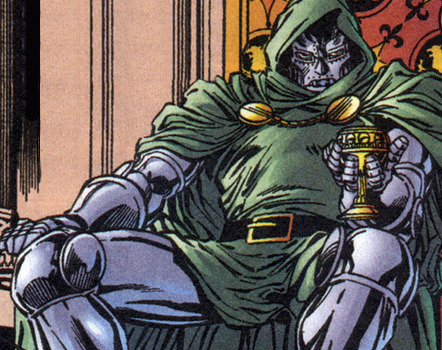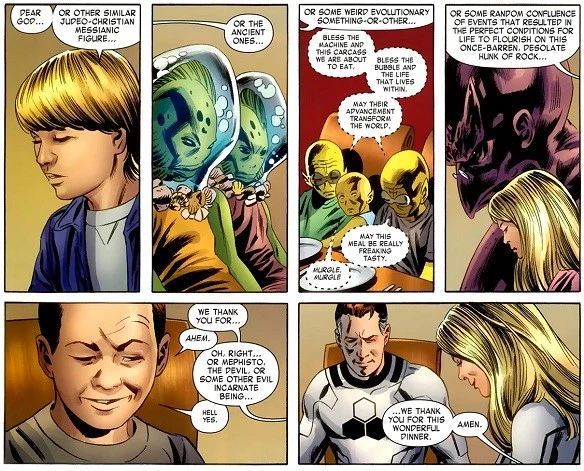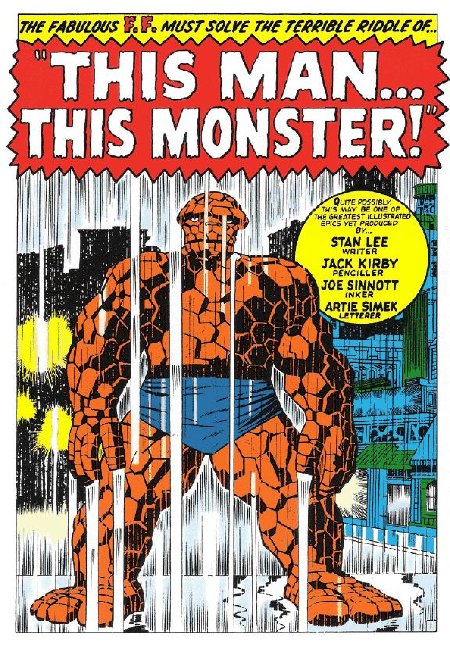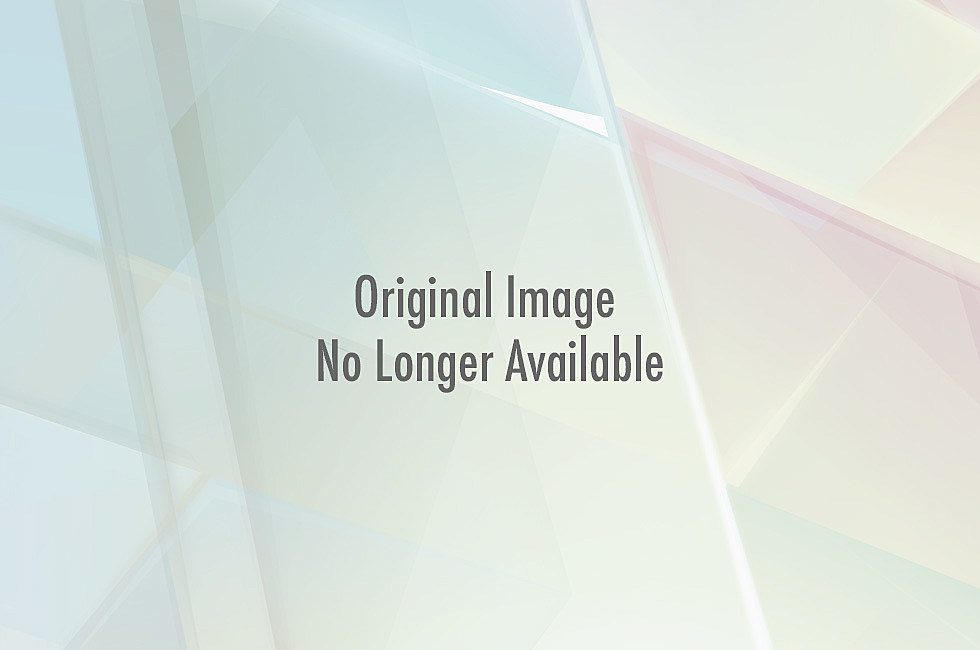Getting to Know Comics: Entry 1- The Fantastic Four
Hello, readers who I assume exist! I welcome you to thy humble blog (AAAND I lost you already, didn’t I?), and the first entry of my ongoing column, Getting to Know Comics! This series is devoted to lending a helping hand to you, the reader who wants to get more into comics, whether they’re a new or casual reader who wants a good place to start! And more experienced readers can read too, I guess, mostly to share and bask in a love for all things comics! Exclamation points are fun AND get attention!
Okay,
intros out of the way, let’s talk superheroes. I love superheroes, more than
just the average person. They WERE my childhood. I literally cannot remember a
time when I wasn’t a fan of Batman- for all I know I was a fanboy since the
zygote stage. I played with my two Spider-Man action figures all the time (it’s
amazing just how many super-cool storylines a young mind can make up about a
good Spider-Man and a much more poseable evil Spider-Man fighting each other,
and occasionally Mr. Freeze, a Beast Machine and that weird alien from Kamino
in Attack of the Clones). I have
dozens of Batman action figures, most of them just different versions of
Batman, because what supporting characters? Whatever my short attention span
caught of superhero shows or movies on TV it did its best to absorb, even if it
was retroactively a piece of s%$& (I’m pretty sure there’s a VHS copy of Batman and Robin still lying around
somewhere...). If you didn’t get the picture, superheroes are a huge part of my
life and what defined (and continue to define) me as a person. Whether it has
anything to do with my excessive use of bracketed side comments has yet to be
determined.
As
I got older though, my tastes and standards evolved and matured, though I am
quite happy to say that I never “outgrew” comics and superheroes. There are
constants that always stick around (like a certain caped crusader that I may
have already mentioned 12 times- and yes, he WILL get an installment in this
column soon enough), but rather than narrowing tastes to a mere few characters,
my interest continues to expand amongst the hundreds of characters in the vast, wonderful
mythologies of comics. When it comes to choosing an answer to the question of
my favorite superhero, it’s often caught in a state of flux, especially when I
find new reasons to love characters I may have never even heard of before.
Batman, Spider-Man, Superman, Daredevil, and so many more- it’s so hard to
choose among the embarrassing riches of daring do-gooders. But when it comes to
choosing my favorite comic book series, a series that I could never get tired
of, could never grow stale, even after decades of stories and multiple re-inventions,
the answer seems both unexpected and obvious: the pioneers of the Marvel Age of
Comics themselves, the Fantastic Four.

Created
in 1961 by writer Stan Lee and artist Jack Kirby, the Fantastic Four redefined
what comics are about, leaving an undeniable impact and inspiration on the
industry and pop culture as we know it. If you somehow don’t know who they are,
here’s a rundown:
Reed Richards, aka Mr. Fantastic: Brilliant
scientist and leader of the Four, driven to use his mind for the betterment of
mankind. He can stretch his elastic body in all manner of ways and shapes
(*insert immature jokes here*).
Susan Storm, aka The Invisible Woman:
Strong-willed, tough and beautiful wife of Mr. Fantastic. She can turn herself
and others invisible, combined with powerful force field abilities because Stan
Lee learned the hard way that invisibility kind of sucks on its own.
Johnny Storm, aka The Human Torch:
Immature, hotheaded (big surprise there) and often egocentric younger brother
of the Invisible Woman. He can ignite into a flying flame and unleash up to nova-levels
of heat.
Benjamin Grimm, aka The Thing: Grumpy yet
big-hearted best friend of Mr. Fantastic. His powers could actually be seen as
a curse, trapped in a giant body of rock, which immense super-strength and
durability doesn’t always make up for.

Here
was a team of superheroes that really stood out from the rest, and in many ways
still do. Rather than having secret identities, the Fantastic Four quickly went
public with their identities, becoming bona-fide celebrities in the process to
the point where Reed and Sue’s wedding is a massive news event. The Thing stood
out as an example of how superpowers could make your life worse, and yet
with a positive outlook and supportive friends he learns to make the best of
the bad hand life dealt him, a message which not enough comics seem to try out
(they figure that emo brooding about their “tortured” souls and being “cursed”
with powers that DON’T make them look like big rock monsters is the preferable
alternative). Johnny Storm was a (initially) teenage character that actually
enjoyed and reveled in his newfound powers, usually having to wait until later
for his often immature and irresponsible antics to bite him in the ass. However,
what is still perhaps the most unique aspect of these characters was that
unlike so many other hero teams where the “family” dynamic was merely thematic
and metaphorical, the Fantastic Four actually WERE a real family, a fact which
became even more pronounced once Reed and Sue had their two children,
super-powered Franklin and hyper-intelligent Valeria. No matter who writes the
book and what the story is, this remains the core facet of the Fantastic Four
which always shines through- the family is always bickering and arguing with
each other (particularly Ben and Johnny), but in the end they’ll always pull
through for one another, supporting each other in their times of need, never
giving up on each other. They are Marvel’s First Family, and even with Marvel
editorial’s insistence on keeping their characters “young”, “fresh” and single,
their lives often stuck in or resetting to a status quo that prevents their
characters from really growing as people (*cough* Spider-Man *cough*), it’s
ironically Marvel’s most old-fashioned characters that have gone through the
most growth and change. At this rate, they’re going to be Marvel’s ONLY family.
And
I haven’t even mentioned the rogues gallery yet. Granted, while some are cool
and very memorable (Galactus, Mole Man, the Wizard and the Frightful Four,
Namor the Sub-Mariner), many others are often held back by the era in which
they were created (Puppet Master, the Mad Thinker, Diablo, the Red Ghost). But
the Fantastic Four’s greatest foe is one hell of a big one, one of the
best-known and memorable characters in the Marvel universe and arguably the
greatest comic book villain of all time: Doctor Doom. Despite not having any
actual powers, here is a list of the many, MANY things Victor Von Doom has
accomplished in his life:
-Become a master of sorcery and technology
-Rules an entire country, his home nation
of Latveria (which tends to give him diplomatic immunity)
-Has successfully taken over the world on
more than one occasion- the first time he did it after stealing the Silver Surfer’s
board and powers cosmic
-Has defeated the Avengers singlehandedly
(despite, again, not really having superpowers, and yes, on more than one
occasion)
-Is the only mind on Earth who could truly
be Reed Richard’s equal
 |
| Pictured: Doctor Doom, prior to you kneeling before him, for he is DOOM! |
There
are countless things that make Doctor Doom a cool villain, but the greatest
part of his character without a doubt is his humanity. Don’t get me wrong, on both
the surface and most of the inside he’s the same Doom he’s always been-
arrogant yet fiendishly intelligent, mad and tyrannical with power, eternally
blaming Reed for his disfigurement, stuck up and above it all (for he is
DOOM!- I'll never get tired of that). But that stuff seems to make him more human, whereas with any
other villain they would feel cartoonish and one-dimensional. He wants to rule
the world not because he’s evil and just ‘cause, but rather he feels that his
way is the best way, that with his superior intellect he can mould the world in
the way that’s best not just for him, but for everybody. He’ s tyrannical and
cruel, yet still acts and thinks with some sense of nobility, a trait that he
uses to hold himself above the common people when it really makes him more like
them. He blames Reed for the accident that disfigured him, when it was Reed who
warned him about the miscalculations in his work, which Doom dismissed as
sabotage, incapable of allowing himself to accept a mistake on his part. You
can often see behind his intimidating, monstrous steel mask a pair of eyes,
scarred and vengeful, pained by the things from his past he can no longer have,
be it the mother he lost at a young age, or the childhood love he gave up to go
to America on the path to power he seemed destined to walk down. Like the
Thing, there IS a soul underneath those eyes encased around a monstrous visage,
a reminder of what they used to be.
Many
fans have agreed that there is a clear divide in how DC and Marvel write
characters, both with their own certain merits. DC writes heroes as icons who
we can look up to and aspire to be like, heroes who stand for truth and
justice, heroes who engage and do battle with the corrupt, the almighty and the
strange. By contrast Marvel writes heroes as mortals who are more like us,
heroes with great power but also great responsibility, heroes who often have
enough trouble dealing with their own personal problems. In the case of the
Fantastic Four, created before later heroes like Spider-Man defined the “Marvel
Method”, they can be said to have it both ways. The characters are people both
ordinary and extraordinary, icons on the surface that barely contain their
plethora of emotions and problems, sometimes down-to-earth (financial troubles,
the constant family bickering), others not so much (supervillain attacks,
keeping good PR). They travel to parallel dimensions and universes constantly,
yet still find time to walk the streets of New York as if their lives aren’t
different from anyone else’s, no matter how untrue that really is. They’ve seen
and done the impossible, yet they never forget where home is. That has to be
the biggest reason why the Fantastic Four immediately connected with readers in
the 1960s, and why they still endure today. People were ready for characters
they could relate to and see as people just like them, but they still wanted
their escapist fantasy bold, colorful and sometimes outright bizarre, as per
the norm of the Silver Age. Keeping a delicate balancing act like that going
for over 50 years? That truly is fantastic.
Recommended
Reads:
-Fantastic
Four by Mark Waid and Mike Wieringo
Issues
#60-70, 500-524, Collected among 4 Ultimate Collection TPB
This
is where I started with Fantastic Four, and I’ve got to say I couldn’t have picked
a better starting point. Waid injected the series with new life in a run so
popular and beloved by fans that there was massive backlash when Marvel decided
to change the creative team midway through their 3-year run (a decision which
was swiftly undone, and everyone moved on as if it never happened). Aided by
the unique, colorful cartoon-style artwork of Mike Wieringo (in the rare case
where I wouldn’t think of the descriptor “cartoon” as derogatory), Waid’s
opening issue “Inside Out” is as pitch-perfect an encapsulation of these
characters as I can possibly imagine ever being written, functioning as both
hilarious and poetic introduction for the uninitiated and poignant, passionate
defense of the Four’s fundamentals that will bring a smile to any fan of these
characters as if to say “this guy GETS it”. And you’d better believe that the
remaining 35 issues of Waid’s tenure on the title more than lives up to the
promise of that opening salvo, reinventing Doctor Doom for what will likely
remain his darkest and most furious encounter with the Four to date, as well as
a brilliant Galactus arc, a new Frightful Four, and even a trip to Heaven, a
story which should have failed for so many reasons yet ends up being altogether
wonderful, possibly one of the best FF stories ever.
 |
 |
| Taken from Fantastic Four #60 |
-Fantastic
Four by Jonathan Hickman
Fantastic
Four #570-588, 600-611 and FF #1-23
A good
pop culture comparison for the Fantastic Four would be the Star Trek series. This initially sounds a bit odd, but think about
it: both are series born in the bold, strange and cosmic decade of the 1960s,
they each center around teams of explorers with unique specialties, and they
both spend many of their stories seeing strange new worlds and civilizations,
going where no man has gone before (*cue fanfare*). The reason I bring up this
comparison now is so I can give you an idea of the kind of intricately-plotted,
cerebral and complex saga that Jonathan Hickman has unfolded before us in the
most recent pages of Fantastic Four, as
well as its relaunch-turned-parallel series FF.
Whereas Mark Waid’s run on the title is comparable to the original Star Trek series, bold and bright and
fun, reveling in its 60s-goofiness and even imbuing it with drama and pathos,
Hickman’s take on the Fantastic Four is more in line with Star Trek: The Next Generation. Like TNG, Hickman’s FF is more intellectual, driven by huge ideas and
conflicts on scales that are often ridiculous in size. There’s thinking on a
big scale, and then there’s Jonathan Hickman, a man who thinks on such a big
storytelling scale it is downright overwhelming at times- he spent 3 years on
one giant, 3-act story, filled with all manner of moving pieces, some of which
take numerous issues before getting their payoff. Needless to say this is a
very daring, very risky approach to storytelling (as many TV writers would
likely attest), but Hickman is a man whose writing exudes a tremendous sense of
confidence, developing into a sincere trust in the reader that they will stick
around, that their investment will prove worthwhile (and believe me, it definitely proves worthwhile). But
despite its plots being complicated and detailed to the point where you may
very well get confused more than once, it’s balanced out by a strong sense of
humanity and a killer sense of humor, keeping things down to earth no matter
how insane the situations can get. And really, the character moments are where
the book truly shines- the lengths Hickman goes to for build-up are just as
much for the big, shocking plot moments as they are for the character moments
both big and small. Waid’s run, like the original Star Trek, is more easily accessible, but like TNG it’s Hickman’s storytelling that ultimately proves more
rewarding.
 |
| A surprisingly typical dinner at the Baxter Building. (Taken from FF #1) |
I
feel special note must go to Hickman’s final issue, FF#23, which has to be one
of the greatest single issues of any comic book I have ever read. As a standalone
issue, it is amazing, filled with laughs, heart, and imagination, an ode to the
overwhelming power and importance of creativity, all brought to life by the
truly stunning artwork of Nick Dragotta, taking inspiration from the famous 60s
Marvel artists like Kirby and Ditko, while modernizing it with a new sense of
fluidity and emotion that makes an impression all its own. But viewed as the
final issue of Hickman’s epic saga, it is truly perfect, an overwhelmingly
beautiful final note of closure to the stories of all these characters old and
new, one that admittedly brought tears to this reader’s eyes in its final
moments.
It
also has vegetarian werewolves. As I said, it’s amazing.
-Fantastic
Four by Stan Lee and Jack Kirby
Issues
#1-103
Yep,
the original stories, the ones that started it all, not just for the foursome
fantastic but for the Marvel universe as we know it. Are they still classics
today like they were 50 years ago? Well, yes and no. There are a lot of
hallmarks of 60s comic book writing that rear their ugly heads- long, constant
gobs of narrative boxes and dialogue, often going into great detail about
what’s going on right as it’s happening, general silver-age goofiness, and a
VERY dated air of 60s sexism, particularly in the earlier issues where poor Sue
Storm’s invisibility is often useless to the point where the book becomes
“Fantastic Three and the Hostage”. However, despite all this I simply cannot
deny how groundbreaking Stan Lee’s work here was, creating heroes and villains
that despite their great powers have real personalities and character
interplay, a surprising amount of which still holds up quite well (particularly
when it comes to just about any response from the ever-lovin’ Thing). The
overly-wordy and descriptive nature of Silver-Age comics will still be a peeve
of mine, but if there’s anyone who really did make it work, it was Stan “The
Man” himself, injecting a goofy yet often sincere sense of fun into every panel.
And Jack Kirby’s iconic artwork and character designs will forever live up to
their storied legacy in comic book history, being every bit as astonishing as
they were when they were first published.
 |
| Gotta respect the classics. |
-Fantastic
Four by J. Michael Stracynski and Mike McKone
Issues
#527-543
Say
what you will about more recent J. Michael Stracynski works (Before Watchmen:
Nite Owl is every bit as bad as the Before Watchmen haters have feared*1),
but he did a lot of great work back when he was at Marvel, namely acclaimed
runs on Thor and Amazing Spider-Man. And while his stint on Fantastic Four
wasn’t long, I have to admit that J.M.S. felt like a perfect fit for the title.
Comics don’t often tend to make me laugh out loud as I read them, but J.M.S.’
has often managed to break that rule for me, and I’ve rarely laughed so hard
reading a superhero comic than I have at his first issue here. Seeing The Thing
become a billionaire is brilliant, and it offers the perfect comedic
counterbalance to the main story, which offers a fascinating and truly cosmic
introspective exploration of the four’s personalities, and how that shaped them
into who they are today. Then there’s the FF’s side of the story in the epic
Civil War event, where we see Reed and Sue’s relationship hit a serious rift
and the Thing leaving the country to become a French resistance fighter (yeah,
you’ll have to trust me on this one). Aided by Mark McKone’s expressive, often
emotional artwork, these often-overlooked tales of the Fantastic Four deserve a
chance, even if Stracynski seems to actually be trying to spoil his
reputation much of these days.
 |
| From Fantastic Four #528 |
Also
Check Out: John Byrne (#232-293), Mark Millar
(#554-569), Dwayne McDuffie (#544-553)
And
in case you’re wondering about the current Marvel NOW run on Fantastic Four by
Matt Fraction, I’ll give a brief two cents: it’s good. Not amazing, and can’t
help but feel like a step back after Hickman’s amazing run, but still a consistently
good book nonetheless. Mark Bagley’s art is solid yet often inconsistent, and
doesn’t seem quite apt enough to capture the “fantastic” part of a Fantastic
Four book. Once again FF, the side title, has proven the superior book despite
Fraction writing both titles (this was also the case for the last couple issues
of Hickman’s run). It helps that it has the awesome artwork of Michael and
Laura Allred, who often cut loose with creative panel layouts and excellent
facial expressions. Both titles are worthwhile, but if you have to choose
between the two, FF is the must-read.

What
to Avoid:
-Fantastic
Four: Season One by Robert Arguire-Sarcasa and David Marquez
Okay,
to be fair, the first entry in Marvel’s recent Season One line isn’t exactly a
bad book by any means (and it's far from the weakest installment so far). I
also can’t deny that David Marquez’s artwork for the book is outstanding, and
makes picking up FF: Season One a tempting prospect merely for the visuals
alone (Marquez has recently been doing artwork for the new Ultimate Comics
Spider-Man, one of my favorite books on the stands right now and a far better
excuse to check out the guy’s art). But I will turn you away from this easy
starting point because while the writing is decent enough (though writer
Arguire-Sarcasa’s frequent use of smashing together sentences to give the
impression of fast-paced rambling speech usually proves clunky and
counterintuitive), this and many other Season One books so far have failed to
really tread new ground of any kind, or inject the origin story with a fresh
perspective and truly take advantage of the potential to reinvent the
characters for a new era. What’s left is a book that’s beautiful to look at and
covers the basic familiar beats but lacks much inspiration, and for characters
like the Fantastic Four you can’t help but expect more than that. This is
further magnified by the inclusion of the first issue of Jonathan Hickman’s
Fantastic Four run as a bonus, which ends up outdoing everything you just read
and making you wonder why you didn’t just start there instead. A nice idea and
a serviceable effort, but you’re better off starting elsewhere.
 |
| Tempting, but there's better ways to start. |
Also
Avoid: Pretty much anything from the 90s. The
general rule stands that 90s comics often suck, what with Liefeld-esque art
style, style-over-substance approach to what could laughably be considered
story, and a penchant for the “X-treme!”. That notwithstanding, 90s Fantastic
Four comics gave us this:*2
 |
| I hate you, 90s comics. |
Well,
I hope you enjoyed this week’s column. Thanks for reading, and tune in next
week for my next Getting to Know Comics profile: Daredevil, The Man Without
Fear!
And
to close things out a quote from the aforementioned FF #23 (aka one of the
greatest comics ever which you should be reading now, and I mean NOW*3):
“So...
...Here’s the thing about adventure. It’s really all there is.
Because here’s the thing about rules. There aren’t any.
Try not to cuss, though.”
*1: “They run. I like it when
they run.” (Actual first line from issue 2. I’m not even kidding, Nite Owl
really does say that. Also, Rorshach cracks jokes, Dan Dreiberg wants vengeance
against his cartoonishly one-dimensional abusive father, and Rorshach threatens
to steal the spotlight away from Nite Owl IN HIS OWN BOOK.)
*2: Because when you think
“Fantastic Four”, you think of Susan Storm’s not-so-invisible cleavage.
*3: You know what, here. Only
$2. Believe me, it’s worth it.
http://www.comixology.com/FF-23/digital-comic/32416
No comments:
Post a Comment